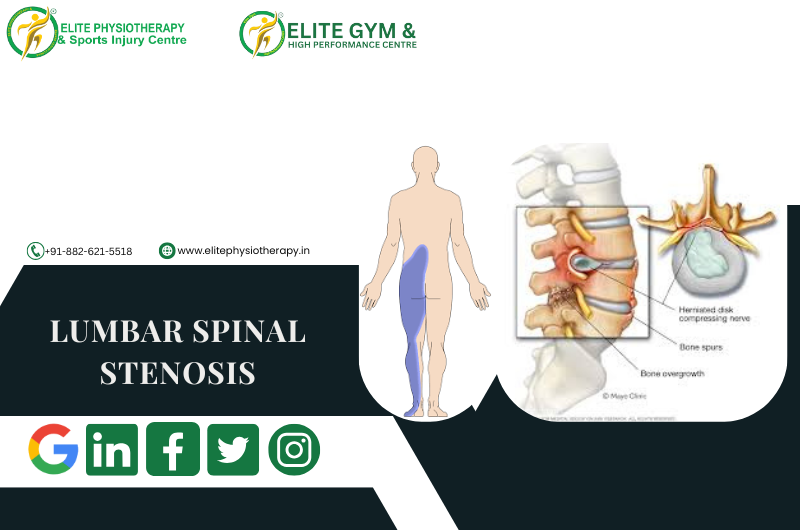Introduction
Our specialty at Elite Physiotherapy & Sports Injury Centre is helping discerning people regain their range of motion, lessen their pain, and improve their function. Lumbar spinal stenosis requires a thorough, scientifically supported physical therapy regimen that is administered with accuracy, compassion, and clarity.
What Causes Lumbar Spinal Stenosis?
Lumbar spinal stenosis is caused by narrowing of the spinal canal or nerve-exit tunnels. Therefore, typical contributors consist of:
- Degenerative changes: facet joint overgrowth, disc bulging or herniation, and thicker ligaments (ligamentum flavum) all contribute to canal narrowing.
- Nerve roots inside the canal are pinched by bone spurs and facet hypertrophy.
- One vertebra slides forward in degenerative spondylolisthesis, which reduces neural space.
- In rare cases, the cause is congenital spinal canal constriction.
Neurogenic claudication is characterized by symptoms such as leg discomfort, numbness, and weakness that get worse when standing or walking and get better when bending forward or sitting.
Physiotherapy Assessment Techniques
To properly customize treatment, a comprehensive physiotherapy evaluation is essential. Important actions consist of:
- History: Examine the onset, postures that aggravate and relieve the condition, and any functional restrictions in the detailed history.
- Observation and gait analysis: take note of antalgic movements, flexed postures, walking patterns, and posture.
- Range of Motion (ROM): Assess both active and passive lumbar flexion and extension using range of motion (ROM); restricted extension may be a sign of facet involvement.
- Palpation: Static or dynamic palpation can be used to identify segmental dysfunction, muscular spasms, or soreness.
- Neurological testing: strength, sensitivity, and reflexes (ankle, knee) aid in identifying nerve involvement.
- Specific tests, such as the Kemps, slump, and straight leg lift, are used to identify nerve stress or root compression.
- Functional treadmill or bicycle stress tests: Stress tests on a functional treadmill or bicycle mimic walking to elicit symptoms and validate neurogenic claudication.
Moreover, these results enable us to distinguish lumbar stenosis from other causes and identify patterns of neurogenic claudication.
Physiotherapy Management at Elite Physiotherapy Centre
Each client is given a customized program that combines functional integration, strengthening, mobility retraining, and manual treatment.
1. Neural decompression and pain relief
- Flexion-based positions: utilizing assistive supports or sitting with your back flexed forward relieves pressure on your nerves.
- Exercises that include lumbar flexion, such as knee-to-chest and pelvic tilts, help to relieve nerve compression and open up neural foramina.
- When used properly, controlled lumbar extension exercises can decompress nerve roots and move disc material; use them only under close supervision.
2. Improvement in Mobility and Flexibility
- To reduce stiffness and enhance functional capacity, gently stretch the hip flexors, hamstrings, and lower back.
- Partial-weight support exercises or aquatic treatment can lower axial load, preserve mobility, and lessen pain.
3. Strengthening and Core Stabilization
- exercises that support spinal alignment by activating the deep core (such as the transverse abdominis) with the pelvic tilt, dead bug, and bridge.
- Gradually strengthening the lower limbs and glutes enhances balance, improves gait, and lowers lumbar demands.
4. Aerobic and Functional Conditioning
- Walking, swimming, and recumbent cycling are examples of low-impact aerobic exercises that improve functional mobility and endurance.
- Gradual advancement with an emphasis on endurance building and symptom-guided pacing.
5. Education & Manual Therapy
- Specific manual procedures to move restricted joints and relieve segmental stiffness.
- Teaching body mechanics, posture, and movement patterns to reduce symptom triggers and increase safe functional utilization.
However Every element at Elite demonstrates our commitment to accuracy and customer results:
Stress our practical manual treatment expertise in conjunction with top-tier, scientifically supported exercise regimens.
Emphasize our individualized treatment, careful observation, and alignment with functional goals in language that is clear, dynamic, and client-focused.
Conclusion
A focused, sympathetic, and function-driven physiotherapy approach is necessary for lumbar spinal stenosis. Additionally, the following are combined at Elite Physiotherapy & Sports Injury Centre:
- Competent evaluation and customized treatment regimens,
- Progressive training for strength, endurance, and mobility,
- Manual interventions that are hands-on,
- Under close observation, flexion-based and potentially extension-based therapies,
- Instruction that promotes long-term recovery
This all-encompassing strategy aids in pain relief, increased walking tolerance, and the restoration of high-level function.





